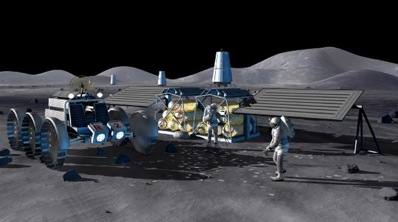
Water found in
Apollo samples
BY EMILY BALDWIN
ASTRONOMY NOW
Posted: 22 July 2010


Traces of water have been found locked up in minerals in the rocks returned from the Moon by Apollo astronauts forty years ago.
Over the last year our view of the Moon has changed considerably – a dry and barren world has turned into a satellite rich in water, largely thanks to missions including the Lunar Reconnaissance Orbiter and Chandrayaan-1. While not flowing rivers or vast oceans that define the Earth, much of the Moon's modest water reservoir is locked up in minerals in the form of hydroxyl, chemically known as OH.
 Heating up lunar rocks such as apatite will release the water component, a technique that will be vital to sustain any future human base on the Moon. Image: NASA. Heating up lunar rocks such as apatite will release the water component, a technique that will be vital to sustain any future human base on the Moon. Image: NASA.
In the latest study, conducted by geologists at the California Institute of Technology and the University of Tennessee, water's signature was found in a calcium phosphate mineral called apatite. “Hydroxide is a close chemical relative of water,” says George Rossman. “If you heat up the apatite, the hydroxyl ions will ‘decompose’ and come out as water.”
The scientists used a sensitive piece of equipment called an ion microprobe to analyse mineral grains that are many times smaller than the width of a human hair, in an Apollo 14 rock sample that was collected in 1971. The instrument works by firing a focused beam of high energy ions at the sample that sputters away some of the atoms, which are collected and analysed in a mass spectrometer.
Looking for water in lunar apatite is not a new idea. “Charles B. Sclar and Jon F. Bauer, geoscientists at Lehigh University, first noted that something was missing from the results of chemical analyses of apatite in 1975,” says Jeremy Boyce. “Now, 35 years later, we have quantitative measurements – and it turns out, they were right. The missing piece was OH. The fact that we were able to quantitatively measure significant amounts of water in a lunar mineral is truly surprising.”
 The rock studied by Caltech and University of Tennessee geologists was collected during the Apollo 14 mission. Image: NASA. The rock studied by Caltech and University of Tennessee geologists was collected during the Apollo 14 mission. Image: NASA.
Furthermore, the results showed that in terms of its hydrogen, sulphur and chlorine contents, the lunar apatite in this particular rock is indistinguishable from apatites produced by Earth's volcanic activity. Carbon dioxide and sulphur gases are generally thought to have dominated many of the Moon's volcanic eruptions, but the discovery of hydroxyl in the Moon's volcanic rocks adds support to the idea that water has also played a role in fueling the eruptions.
Just how much water is still an open question, though. The amount of water found in the study sample is just 0.16 percent by weight, and apatite is not abundant, forming under circumstances that tend to concentrate hydrogen to much higher levels than are present in its host rocks or the Moon as a whole.
The results are still significant though, filling in vital information about the Moon's evolutionary history. “These findings tell us that the geological processes on the Moon are capable of creating at least one hydrous mineral,” says John Eiler, also of Caltech. “Recent spectroscopic observations of the Moon showed that hydrogen is present on its surface, maybe even as water ice. But that could be a thin veneer, possibly hydrogen brought to the Moon’s surface by comets or solar wind. Our findings show that hydrogen is also part of the rock record of the Moon, and has been since early in its history.”
|



